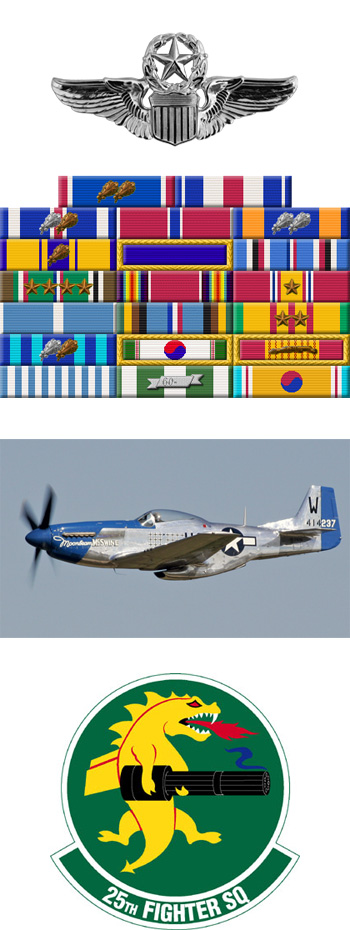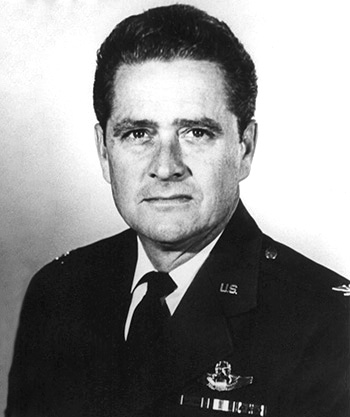
|
William T. Whisner |
 |
|||
| Rank, Service | ||||
Colonel O-6, U.S. Air Force |
||||
| Veteran of: | ||||
|
||||
| Tribute: | ||||
Bill Whisner was born on October 17, 1923, in Shreveport, Louisiana. He enlisted in the Aviation Cadet Program of the U.S. Army Air Forces on March 16, 1942, and was commissioned a 2d Lt and awarded his pilot wings at Napier Field, Alabama, on February 16, 1943. After completing P-47 Thunderbolt training, he was assigned to the 487th Fighter Squadron of the 352nd Fighter Group, and deployed with the group to England in July 1943. Between January 1944 and January 1945, Capt Whisner was credited with the destruction of 15.5 enemy aircraft in aerial combat plus 2 probables and 3 on the ground while strafing enemy airfields. After returning to the U.S. he left active duty and served in the reserves from August 24, 1945, to August 31, 1946. He then went back on active duty and served with the 56th Fighter Group at Selfridge Field, Michigan, from September 1946 to April 1947, and then with the 334th Fighter Squadron of the 4th Fighter Group at Andrews Field, Maryland, from April to September 1947. He then served for a short time at Bolling AFB, Washington, D.C., and then with the 61st Fighter Interceptor Squadron of the 56th Fighter Interceptor Group at Selfridge AFB. In September 1951, Maj Whisner deployed with the 334th Fighter Interceptor Squadron to Korea, where he destroyed 2 enemy aircraft in aerial combat and damaged 4 others, before joining the 25th Fighter Interceptor Squadron of the 51st Fighter Interceptor Wing in November 1951. He then destroyed another 3.5 enemy aircraft with 2 more damaged, for a two-war total of 21 destroyed in the air, 2 probables, 6 damaged, and 3 destroyed on the ground, making him one of only 7 people to have been an ace in both World War II and the Korean War. Whisner returned to the U.S. in March 1952 and served with the 3596th Flying Training Squadron at Nellis AFB, Nevada, until December 1954, when he went to Randolph AFB, Texas, to serve on the staff of Headquarters Crew Training Air Force. Col Whisner then served as a Royal Air Force exchange officer in London, England, from February 1956 to April 1957, followed by service as commander of the 494th Tactical Fighter Squadron at Chaumont AB, France, from April 1957 to April 1959. He then served on the staff of the Armed Forces Special Weapons Project at Sandia Base, New Mexico, from April 1959 to June 1962, and then as a special assistant to the commander for the Combat Crew Training Group at Luke AFB, Arizona, until September 1962, when he became commander of the 4517th Combat Crew Training Squadron at Luke. After completing Vietnamese Language School, he served as an Operations Staff Officer with Headquarters 2nd Air Division at Tan Son Nhut AB in the Republic of Vietnam from October 1963 to October 1964, followed by service on the staff of Pacific Air Forces at Hickam AFB, Hawaii, from October 1964 to October 1967, during which time he made several deployments to Southeast Asia. Col Whisner then served as Chief of the Fighter Division with Headquarters Tactical Air Command at Langley AFB, Virginia, from October 1967 to June 1969. He was commander of the 48th Tactical Fighter Wing at RAF Lakenheath, England, from February 1970 to March 1971. Col Whisner retired from the Air Force at Kirtland AFB, New Mexico, on July 31, 1972. He died on July 21, 1989. |
||||
|
||||

